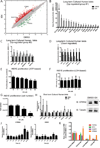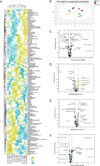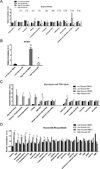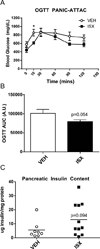Isoxazole Alters Metabolites and Gene Expression, Decreasing Proliferation and Promoting a Neuroendocrine Phenotype in β-Cells
- PMID: 26828310
- PMCID: PMC5198576
- DOI: 10.1021/acschembio.5b00993
Isoxazole Alters Metabolites and Gene Expression, Decreasing Proliferation and Promoting a Neuroendocrine Phenotype in β-Cells
Abstract
Novel strategies are needed to modulate β-cell differentiation and function as potential β-cell replacement or restorative therapies for diabetes. We previously demonstrated that small molecules based on the isoxazole scaffold drive neuroendocrine phenotypes. The nature of the effects of isoxazole compounds on β-cells was incompletely defined. We find that isoxazole induces genes that support neuroendocrine and β-cell phenotypes and suppresses genes important for proliferation. Isoxazole alters β-cell metabolites and protects glucose-responsive signaling pathways under lipotoxic conditions. Finally, we show that isoxazole improves glycemia in a mouse model of β-cell regeneration. Isoxazole is a prime candidate to alter cell fate in different contexts.
Figures





Similar articles
-
Isx9 Regulates Calbindin D28K Expression in Pancreatic β Cells and Promotes β Cell Survival and Function.Int J Mol Sci. 2018 Aug 27;19(9):2542. doi: 10.3390/ijms19092542. Int J Mol Sci. 2018. PMID: 30150605 Free PMC article.
-
Geniposide promotes beta-cell regeneration and survival through regulating β-catenin/TCF7L2 pathway.Cell Death Dis. 2015 May 7;6(5):e1746. doi: 10.1038/cddis.2015.107. Cell Death Dis. 2015. PMID: 25950476 Free PMC article.
-
Short-term selective alleviation of glucotoxicity and lipotoxicity ameliorates the suppressed expression of key β-cell factors under diabetic conditions.Biochem Biophys Res Commun. 2015 Nov 27;467(4):948-54. doi: 10.1016/j.bbrc.2015.10.038. Epub 2015 Oct 20. Biochem Biophys Res Commun. 2015. PMID: 26471305
-
Differential gene expression between Zucker Fatty rats and Zucker Diabetic Fatty rats: a potential role for the immediate-early gene Egr-1 in regulation of beta cell proliferation.J Mol Endocrinol. 2005 Aug;35(1):13-25. doi: 10.1677/jme.1.01792. J Mol Endocrinol. 2005. PMID: 16087718
-
Gene expression regulated by pioglitazone and exenatide in normal and diabetic rat islets exposed to lipotoxicity.Diabetes Metab Res Rev. 2009 Feb;25(2):163-84. doi: 10.1002/dmrr.896. Diabetes Metab Res Rev. 2009. PMID: 19065603
Cited by
-
Recent Advances in the Synthesis of Oxazole-Based Molecules via van Leusen Oxazole Synthesis.Molecules. 2020 Mar 31;25(7):1594. doi: 10.3390/molecules25071594. Molecules. 2020. PMID: 32244317 Free PMC article. Review.
-
α2-Adrenergic Disruption of β Cell BDNF-TrkB Receptor Tyrosine Kinase Signaling.Front Cell Dev Biol. 2020 Oct 15;8:576396. doi: 10.3389/fcell.2020.576396. eCollection 2020. Front Cell Dev Biol. 2020. PMID: 33178692 Free PMC article.
-
Stearoyl-CoA desaturase 5 (SCD5), a Δ-9 fatty acyl desaturase in search of a function.Biochim Biophys Acta Mol Cell Biol Lipids. 2021 Jan;1866(1):158840. doi: 10.1016/j.bbalip.2020.158840. Epub 2020 Oct 10. Biochim Biophys Acta Mol Cell Biol Lipids. 2021. PMID: 33049404 Free PMC article. Review.
-
Small Molecule-mediated Insulin Hypersecretion Induces Transient ER Stress Response and Loss of Beta Cell Function.Endocrinology. 2022 Jul 1;163(7):bqac081. doi: 10.1210/endocr/bqac081. Endocrinology. 2022. PMID: 35641126 Free PMC article.
-
Calcineurin/NFATc2 and PI3K/AKT signaling maintains β-cell identity and function during metabolic and inflammatory stress.iScience. 2022 Mar 19;25(4):104125. doi: 10.1016/j.isci.2022.104125. eCollection 2022 Apr 15. iScience. 2022. PMID: 35402865 Free PMC article.
References
-
- Vetere A, Choudhary A, Burns SM, Wagner BK. Targeting the pancreatic beta-cell to treat diabetes. Nat. Rev. Drug Discovery. 2014;13:278–289. - PubMed
Publication types
MeSH terms
Substances
Grants and funding
LinkOut - more resources
Full Text Sources
Other Literature Sources
Molecular Biology Databases

